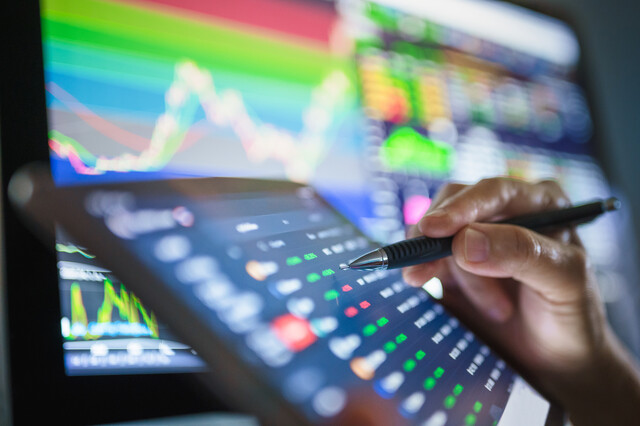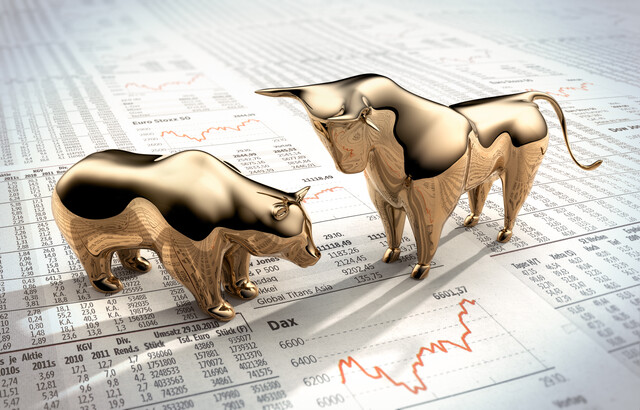Online Class: Investing 201 — Intro to Commodity, Options, and Futures Markets

no certificate
with CEU Certificate*
-
13Lessons
-
33Exams &
Assignments -
2,712Students
have taken this course -
8Hours
average time -
0.8CEUs
Course Description
Mastering the Art of Futures Trading: Your Comprehensive Guide
Have you ever been intrigued by the ebb and flow of corn prices on the commodities market? Perhaps you possess a penchant for taking calculated risks, a zest for exhilarating financial ventures, or an allure to the strategic game that is trading. The realm of futures trading, often dynamic and tinged with emotion, promises lucrative returns, making it a magnet for those with a keen financial acumen. Indeed, it offers an opportunity to not only trade with personal accounts but also manage portfolios for a diverse clientele. Experiencing successful trades in this domain is undeniably thrilling. However, a caveat: futures trading is not everyone's cup of tea. The stakes are high, and uninformed trading decisions can lead to significant monetary setbacks.
As of 2023, the futures market has witnessed an upward trajectory in terms of volume and global participants. Recognizing the burgeoning interest and the critical need for education in this space, we present "Investing 201: Commodity Markets and Futures Trading". This course stands as a lighthouse for those navigating the turbulent waters of futures trading.
Course Overview:
Investing 201: Commodity Markets and Futures Trading delves deep into the intricacies of the commodity and futures landscape. Beginning with the roots of commodity markets, it traverses through the mechanics of futures trading, demystifying complex jargon and decoding the nuances of charts.
What's in Store?
-
History of Commodities Markets: Journey through time and explore the genesis, evolution, and milestones of commodity trading.
-
Futures Markets: Unravel the dynamics of futures markets, their significance, and the forces that shape them.
-
The Contract: A deep dive into the essence of trading – the contract. Understand its formulation, components, and significance.
-
Contract Types: Decipher the various contract types available in the market and their unique attributes.
-
Making a Trade: Transition from theory to practice. Learn the steps, strategies, and subtleties of executing a trade.
-
Trading on Margin: Understand the concept of margin trading, its advantages, risks, and real-world applications.
-
Regulatory Environment: Navigate the rules of the game. Familiarize yourself with the regulatory bodies, frameworks, and compliance mandates.
-
How the Markets Work: Decode market mechanisms, influencers, and the interplay of various factors that drive prices and trends.
-
Options: Explore the versatile world of options trading, its strategies, and applications.
-
Trading Strategies: Equip yourself with proven trading methodologies, tactical approaches, and decision-making frameworks.
-
Charts: Charts are the heartbeats of trading. Learn to interpret, analyze, and derive actionable insights from them.
-
Trading Systems: Delve into automated trading systems, their design, advantages, and practical utility.
-
Careers in Futures Trading: Discover potential career paths, roles, and opportunities in the futures trading ecosystem.
Who Should Enroll?
If you're someone who doesn't waver easily under market pressure, can gracefully navigate through losses, and possesses the financial bandwidth to learn while on the job, then futures trading might just be your calling. But, before you plunge, understanding the basics is pivotal. This course is tailor-made to provide you with a robust foundation.
The Futures Trading Advantage:
The futures market, with its vast potential, has been a realm where many have found not just monetary success, but also a fulfilling career. According to a 2023 report, the global futures market has grown exponentially, attracting a myriad of investors and traders. Such growth underscores the need for well-informed, strategic, and educated participants.
Conclusion:
In a world where financial decisions can make or break fortunes, being well-prepared is not just an advantage; it's a necessity. "Investing 201: Commodity Markets and Futures Trading" is not just a course; it's your mentor, guide, and the first step towards a potential career in futures trading. Equip yourself with knowledge, refine your strategies, and step confidently into the world of futures trading.
- Completely Online
- Self-Paced
- Printable Lessons
- Full HD Video

- 6 Months to Complete
- 24/7 Availability
- Start Anytime
- PC & Mac Compatible
- Android & iOS Friendly
- Accredited CEUs

Course Lessons
Lesson 1. Origins of Commodities Trading
The 1970s marked a revolution in futures trading with the introduction of financial futures, allowing traders to speculate on currencies and financial instruments beyond physical commodities. The following decades saw the expansion of futures markets to encompass stock indexes and government debts, greatly increasing their scope.Lesson 2. Faces and Forces of Futures Trading
The futures market, historically pivotal for agricultural societies, now encompasses energy and financial products, with exchanges like NYMEX and ICE driving global economic participation. Through futures contracts, companies mitigate risks such as fuel price volatility and currency fluctuations.Lesson 3. Futures Contracts Unveiled: Pricing Dynamics and Strategic Insights
Futures contracts represent an agreement to trade a particular asset at a set future date and price, offering a strategic hedge against market volatility. The lesson dissects these contracts' standard and flexible types, providing insights into their unique features and pricing models.Lesson 4. The Expanding Universe of Futures Trading
Futures trading has grown from simple agricultural hedges to encompass a vast array of asset classes, including metals, energy, and stock indices. This lesson offers insights into the mechanics of different contract types and emphasizes strategic uses and market impacts.Lesson 5. Futures Trading 101
Investors can open various trading accounts, from full-service to self-directed, to participate in futures markets. Through comprehensive analysis and strategic order execution, both novice and experienced traders can navigate futures markets to capitalize on market opportunities.Lesson 6. Understanding Margin in Futures Markets
Margin in futures trading allows leveraging positions beyond personal capital, amplifying both potential gains and losses from price changes. Critical concepts include initial and maintenance margins, margin calls, and leveraging differences between margin and cash trading.Lesson 7. Guardians of Integrity: The Regulatory Landscape of Futures Markets
Oversight of futures and options trading is vital in preventing market abuses, with the CFTC and NFA playing pivotal roles in protecting market participants. These regulatory entities, alongside self-regulating exchanges, work to maintain a fair, transparent, and ethical trading environment.Lesson 8. Futures Market Fundamentals: A Comprehensive Guide
As futures contracts are traded, clearinghouses step in as essential intermediaries, securing transactions and maintaining market integrity. Traders benefit from discovering the dynamics of price movements and market slippage, factors that can elevate or diminish trade profitability.Lesson 9. Maximize Profits, Minimize Risks: Mastering Futures Options
Call and put options have distinct roles based on market predictions, with calls purchased for bullish futures expectations and puts for bearish outlooks. Premiums and strike prices are essential to option valuation, impacting intrinsic and extrinsic values and determining in-the-money, at-the-money, or out-of-the-money status.Lesson 10. Mastering Futures: Essential Strategies and Techniques
Successful futures trading demands strategic plans, using either fundamental or technical analysis and sometimes spread trading to navigate market complexities. A well-rounded trader combines strategic discipline and robust risk management to thrive in the volatile futures market landscape.Lesson 11. Visual Insights: Leveraging Price Charts and Indicators
Charts in futures trading are vital for visualizing price trends and market conditions, equipping traders with the insights necessary to make strategic decisions. Mastery of various chart styles and indicators is essential for success in technical analysis and informed trading.Lesson 12. Building Consistency with Trading Systems: Overcoming Emotional Trading Challenges
A trading system acts as a blueprint for futures traders, establishing a systematic method based on technical indicators and historical data for disciplined trade execution. It supports informed decision-making and reduces emotional bias, though its effectiveness is dependent on thorough testing and adaptation to varying market conditions.Lesson 13. Unveiling the Careers in Futures Trading: A Guide to Success
The lesson explores careers in futures trading, emphasizing two main paths: self-directed trading with its freedom and risks, and trading on behalf of clients, requiring formal education and licensing. It outlines various roles such as Associated Person, Commodity Trading Advisor, and more, each with specific responsibilities and growth potential.
Learning Outcomes
- Define the historical development of commodities and futures trading from ancient barter systems to modern electronic markets.
- Identify the primary categories of commodities and their unique characteristics influencing their interchangeability.
- Analyze the historical evolution of futures markets and discuss the impact of technological advancements on trading practices.
- Identify and differentiate the roles of major futures exchanges in the United States and globally, demonstrating their contributions to market innovations.
- Analyze how market factors such as spot price, forward price, carrying costs, and dividends influence futures contract pricing.
- Define the components and terms of a futures contract, including asset type, quantity, delivery date, and location.
- Describe the differences between physical delivery and cash settlement futures contracts, and explain how each impacts market participants' trading strategies.
- Identify and categorize various types of futures contracts based on their underlying assets, including agricultural, metals, energy, currency, interest rate, and index contracts.
- Demonstrate the ability to execute various order types, including market, limit, and stop orders, to effectively manage risk and capitalize on trading opportunities in futures markets.
- Recognize and describe key patterns in futures trading charts, such as the 'head and shoulders,' to predict potential market reversals.
- Demonstrate the ability to calculate leverage and margin requirements in futures trading using real-world scenarios.
- Identify and explain the differences between initial margin and maintenance margin, and the implications of margin calls in trading contexts.
- Identify and describe the roles of major regulatory bodies involved in futures markets, such as the CFTC and NFA.
- Demonstrate mastery of lesson content at levels of 70% or higher.
Additional Course Information

- Document Your Lifelong Learning Achievements
- Earn an Official Certificate Documenting Course Hours and CEUs
- Verify Your Certificate with a Unique Serial Number Online
- View and Share Your Certificate Online or Download/Print as PDF
- Display Your Certificate on Your Resume and Promote Your Achievements Using Social Media

Choose Your Subscription Plan
No Certificate / No CEUs
This course only
| Includes certificate | X |
| Includes CEUs | X |
| Self-paced |

|
| Instructor support |

|
| Time to complete | 6 months |
| No. of courses | 1 course |
Certificate & CEUs
This course only
| Includes certificate |

|
| Includes CEUs |

|
| Self-paced |

|
| Instructor support |

|
| Time to complete | 6 months |
| No. of courses | 1 course |
Certificates & CEUs
Includes all 600+ courses
| Includes certificate |

|
| Includes CEUs |

|
| Self-paced |

|
| Instructor support |

|
| Time to complete | 12 Months |
| No. of courses | 600+ |
Certificates & CEUs
Includes all 600+ courses
| Includes certificate |

|
| Includes CEUs |

|
| Self-paced |

|
| Instructor support |

|
| Time to complete | 24 Months |
| No. of courses | 600+ |
Student Testimonials
- "This course was extremely helpful and I am excited to apply what I have learned." -- Shaquinthia H.
Related Courses
-
 7 hours
0.7 CEUs
Introduction to Logic
+ More Info
7 hours
0.7 CEUs
Introduction to Logic
+ More Info
-
 32 hours
3.2 CEUs
Accounting & Bookkeeping 101 for Everyone
+ More Info
32 hours
3.2 CEUs
Accounting & Bookkeeping 101 for Everyone
+ More Info
-
 4 hours
0.4 CEUs
Business Analysis
+ More Info
4 hours
0.4 CEUs
Business Analysis
+ More Info
-
 6 hours
0.6 CEUs
Debt Reduction
+ More Info
6 hours
0.6 CEUs
Debt Reduction
+ More Info
-
 5 hours
0.5 CEUs
Personal Finance 101: How to Manage Your Money
+ More Info
5 hours
0.5 CEUs
Personal Finance 101: How to Manage Your Money
+ More Info
-
 4 hours
0.4 CEUs
Business Budgeting 101: How to Plan, Save, and Manage
+ More Info
4 hours
0.4 CEUs
Business Budgeting 101: How to Plan, Save, and Manage
+ More Info
-
 6 hours
0.6 CEUs
Sustainable Development for Business
+ More Info
6 hours
0.6 CEUs
Sustainable Development for Business
+ More Info
-
 7 hours
0.7 CEUs
Organizational Behavior in Business
+ More Info
7 hours
0.7 CEUs
Organizational Behavior in Business
+ More Info
-
 5 hours
0.5 CEUs
Habits of Millionaires
+ More Info
5 hours
0.5 CEUs
Habits of Millionaires
+ More Info
-
 7 hours
0.7 CEUs
Understanding Financial Statements
+ More Info
7 hours
0.7 CEUs
Understanding Financial Statements
+ More Info
-
 7 hours
0.7 CEUs
Financial Analysis 101: Planning and Control
+ More Info
7 hours
0.7 CEUs
Financial Analysis 101: Planning and Control
+ More Info
-
 12 hours
1.2 CEUs
Business Math 101
+ More Info
12 hours
1.2 CEUs
Business Math 101
+ More Info





